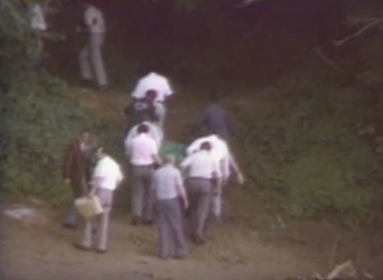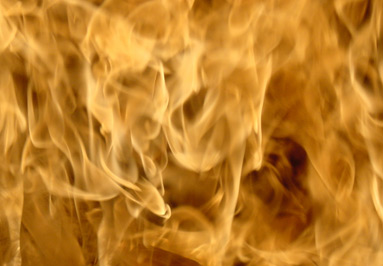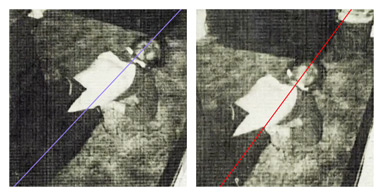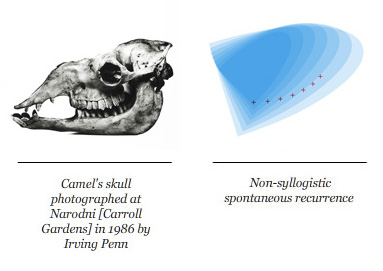S-22 was a rote-building structure located on 1st Place in Carroll Gardens. It was a control station, the first ever based on a “control and duplicate” design. Multiple systems of non-dialectic, non-syllogistic spontaneous recurrence backed up by twin systems installed throughout the facility were operated by two paired control rooms, Block Sigma and Block Zeta [often used as a metonym for S-22], and linked via looped passages and revolving couriers. The principal components and functions of the systems included:
— Annihilators;
— Daisy-chained precipitating stressors;
— Actuators to dishevel arcs of time and to feign substance;
— Iteration systems to keep the simulations dual.
The facility was operating under the guidelines of S-28 [a structure in many respects sympathetic to the underwhelming theories of metaness that were de rigueur at S-75], under the sanctimonious supervision of a man identified only as Victor, and staffed at the toll of six per control room by a dozen scientists with security clearance as extreme as fifteen levels above ultrasecret. Victor was a twin survivor with Klein blue eyes and a baboon mane, Leachman Cloris scowls, Nat King Cole knobbed cheekbones, pentagonal and bony but musculous, unfavorably known to the other facilities for his prying behavior, Mary Mercy sightings, presumed nonsexual necrophilic inclinations which were never averred but that some surmised in the many cues of his gaze and strut, and his sinister references to Husserl’s “ideally closed system of truths.” The otherness of death seemed to be his obsession. And sadness, triteness, ontic entities. He died in 2009 shot from above multiple times and his corpse cleansed and dressed in black was, after his name had been changed to Damien Steven Hirst, auto-da-féed until nothing was left to despise.


The changes occurring during cremation were watched. It was found that at temperatures between 670 and 8108C the body showed the “pugilistic attitude” after about 10 minutes. After 20 minutes the calvaria was free from any soft tissue and fissures of the tabula externa could be noticed. The body cavities became visible after approximately 30 minutes, so that the organs were exposed. Forty minutes after cremation had started, the internal organs were severely shrunken and showed a net-like or sponge-like structure. After about 50 minutes the extremities were destroyed to an extent leaving only the torso which broke apart after 1–1.5 hours. The complete incineration of a human body took about 2–3 hours.
Forensic Science International, 95 (1998)
Although all S-22 information [supposing truth was a non-pair] was out there, it’s only after the closing of S-22 following the vivicomburium of Victor, and after a circumstance which presented itself as a deranged mentality [a change in a person's mood] strengthened the opinion entertained by a large number that S-22 was a simulation, that details regarding Project Sigma and Project Zeta started to be explored. It emerged that the main activities of S-22 were to monitor and simulate all aspects of S-56?s activities, and to provide S-75 with restricted authorizations to maintain S-56?s activities.
?
Jeffrey Brodkey (1926–1968), known as the Brodkey brother, son of Victor Brodkey (1888–1955), a Brooklyn obstetrician whose authority was often bucked, whose spouse Anita LaVoya Z. Kuch (1894–1948) was a former radio actress of French ancestry, attended New York University and obtained a Doctorate degree in the field of Obstetrics and Gynecology and a minor in Literature, though New York University has no records of his attendance. He was found dead in the Carroll Gardens family house extinct by pistol suicide, the dark triad of sadness—how to envisage sadness, how to give sadness precise contours, how to clear it from the body—, blood spilled for blood, natural oak flooring. Among the pieces of importance found in the library were books, two spiral notebooks which exhibited identical contents, and a camel’s jawbone.
Jimmy “James” Brodkey, ascertainably sired by Jeffrey Brodkey, born in 1952 and sole scion of the Brodkey family, studied Psychopathology and Criminology at the University of California at Berkeley and joined the FBI Behavioral Unit in 1981. From his father Jeffrey he inherited a mania for animal heat, rhizome-dependent systems, a raucous voice and a manner of standing still, and from his mother a proclivity for the practice of French and mood swings.

He was now living in Quantico and he gulped the pungent chalice of sensational homicides. His clearance rate reached 90 per cent and from hence he co-authored Unimportance and Probabilistic Approaches to Crime Scenes (Imperial Press, 1986) with Vito Possolipo, a Palo Alto County Sheriff’s Department homicide detective, which described at length a novel criminal investigative technique designed to analyze and compare organized and disorganized modi operandi, rituals and signatures of offenders in non-serial cases.
In 1990, Brodkey started to take notes for what seemed to be a book project intended to theorize the dynamics of “certain disorders of simulation.” The working title for the project was Die progressive Paralyse.
Brodkey told Dr. Mary Z. Mip that Die progressive Paralyse was not a creation of his imagination but a carbon of the notebooks his father had left behind postmortem and, Brodkey asserted, wrote. “I never wrote a single complete sentence of my own,” Brodkey said. He also explained that the purpose of Die progressive Paralyse was, he believed, to go from “two to three.” [conversely, the purpose of Unimportance, Mip thought, was to go from "one to one."]
“It’s like water on sand,” he repeated. “It uses a story to tell a different story. It uses the letters of the word Yes to write the word No. It needed to be done, did it not?”
Although Mip observed that Brodkey made these “confidences” at a time of severe emotional stress when his inference-making ability was most impaired ["I have seen very pale faces with flamed spite. I have heard hushes in five different octaves. But have I seen what a genuine virtue saying the truth was?"], she handed Die progressive Paralyse to forensic cryptographers who examined the text and established certain convictions:
Structure:
? It was apparently composed of seven parts, or chapters, each composed of a number of sections whose divisions were incalculable.
? The exact number of sections could not be determined either [it remained unknown], for missing were some pages, combined some others. Moreover, and it contributed a supplemental confusing element to the architecture of the book, the sections were arranged by permutations of letters, which created a “caterpillar effect” [six-letter words with no second letter were reduced to a "root" such that each fifth letter revealed a single seven-letter word; seven-letter words with no first letter were reduced to a second "root" such that each fourth letter revealed a single eight-letter word; et cetera, mutatis mutandis].
? The second chapter was believed to be the fourth chapter, and the sixth the first, the seventh the fifth.
Next sprang a debate as to whether or not Die progressive Paralyse was encrypted, allegorical, or noumenal. No one contested the specious flagrancy of sense and springs of formidable logic—some literate souls compared the abstruseness of Die progressive Paralyse to that of the Cahiers de Rodez and L’Expérience intérieure. What was questioned and disputed were the origin and purposiveness of the text and the probabilities of its ultimate significance, if a buried layer of sense, even buried for always, a non-poetic shadow bating across the apparent first plan text, thriving behind the drapes, jutting up into the wisdom above chaos, could be pointed and exhaust all interpretations, or if the text was a Sphinx Without a Secret.
Structure and meaning:
? Discrepancies between sentence truncations and circumlocutions were uncloaked, repetitions and similarities were disidenticalized. An algorithm based on sundry alphabet systems and statistical tests was devised and intervals, lengths, flows were measured.
The results surprised Mip. No hidden meaning was disclosed but formal coincidences with other texts surfaced sparsely and posited that Die progressive Paralyse was a mixture of preexistent texts, some as old as 1677 and earlier, that the author had most unquestionably dismembered and reinterlaced, and rendered untraceable—only short sections of less than five words were found to fully match antecedent texts [an extremely sophisticated bricolage assuredly]. As if it had been dead and made of bones and death, femurs, mandibles, scapulae, sacra, and intransitively turned out into a dead spine rather than a bag of bones, a syngamy rather than a sum, Die progressive Paralyse was made of multiple parts recomposed into one, multiple parts put into a new relation of rest, a difference born out of resemblences.
Conclusion:
? While its arrangement was undoubtably an emanation of pre-existing texts, as, as it would be shown later, were these texts themselves combo effects of precursory texts which too were amalgams of quondam and prequondam literature, themselves detached like blocks of ice from a prime corpus, itself an nth equation of language made of morphemes bound by a grammar, in such a way that no text could cause itself to exist, that no very root could be traced back, its possible significance, per contra, if exhumed, would not be subsequent to preexisting philosophies and utopias, preexisting ideas and systems, but mothered ex nihilo, growing out of itself, fundamentally exact like the pairing of two things that are same, like two absences.
?

The interrelation between simulations was often referred to as “Victor’s Nuance Principle.” Franz Varelli who was working with Bames at S-68 defined the Nuance Principle as follows:
A simulation cannot be operated in isolation. If it seems to be, it’s because you don’t understand the simulation well enough. A simulation is always fit into an overall pattern of simulations which propagate a variety of swarm behaviors that cannot be predicted from the knowledge of single simulations. It’s always an ensemble of more than one simulation because simulations develop by dint of nuances that cannot be induced out of a single simulation. By definition, a nuance separates at least two distinct simulations, making them look unconnected—which they are not. It’s a language of difference.
In 2009, experiments at S-75 implemented a proposal of S-28 to confirm the principle. Although the relation between the nature of a simulation and its interpretation could simply not be proven, it was believed an aspect of the interpretation must necessarily derive from subdued nuances, and this assumption provided a direct characterization of the conduct of subservience-based nuances. “Nuance” was defined as a fixed degree of a circumstance relative to simulation behavior. “Fixed” meant that the degree didn’t change and stayed “unmelted,” which was in contradiction to the Law of Persistence [The Law of Persistence applicable to simulations is that a circumstance cannot prove relative to a simulation any behavior not supposed in the overall pattern either as a circumstance of reiteration or as a proof that the simulation is an interpretation]. S-75 confronted this aporia nonetheless, tried to enact a self-factorable simulation [definable by the total number of its nuances], and the experiment went awry. They thought that by “freezing” transfinite nuances, as they were called, into simulations, they would introduce some type of hypo-mechanism into the whole system, and eventually be able to prove that anything was equal. But simulations, as they witnessed, self-replicated faster than nuances. Did they think it could go down to zero? I don’t think so, but it happened.
?
The people at S-75 used to talk about the peculiarity of what they had done and pretended it wasn’t true. They had a list of words that they considered to be “false,” words they were not permitted to use, or regarded as “accusatory,” or just ignored [some "words" were dashed depictions]. When S-22 questioned them about that list they denied its existence. Of course S-22 knew they were lying. Not only people at S-28 confirmed as much, but far too many times “false words” slipped lapsusly for the list not to be true. It was part of that “simulation pairing.” An unbroken whole, a picrocholine metaness of fumes, Erinyes, Furies, horizontal and vertical shafts, archetypes of truth, all numb and murderously stupefacient, vowed to voidness and enforcing a sort of submission, a sort of fatigue, all S-75, all its activities.
A doubt draped in a flag of condescending monism and faux mansuetude it was and Victor wasn’t impressed, eventually proceeded to obtain the list and started Project Zeta. S-75 then established a counter-dialogue with S-22, disseminated new dishonest material to test Victor, to see if he would comply with their inconstancy and work out a “refined theory,” if he would “adapt,” but when he [cunningly] humored S-75 with a speculation that spurred the list theory to new levels, they then created a third or fourth list to perplex him and S-22 even more, then modified the list again, and again until disconsolate confusion and expectations co-saturated and put the whole advancing theory of Victor in a pat position.
Though data showed that the second list of words could have been in sooth fifth or sixth, it contained parts arranged thematically that suggested that it may, along with the earlier versions, have been a draft in progress meant to be recast into a longer single list never to be completed, a nonexistent “knowledge” that no one at S-22 would ever hold. Even at S-75, these preliminary lists created incertitude and roused rancor. It made them feel they were part of a phenomenology of change they needed to substantiate and defend even though they knew it was a placid trot throughout spuriousness. And that was a well-established fact that adequate demonstrations explained. For instance, when cryptographers at S-22 analyzed the S-75 “typology” and questioned its rigor, they found that the attributes of falsity and redundancy applied to all the lists [and activities], as did many other truistic categories, and concluded that the falsity and redundancy classifications should be eliminated unreservedly. They believed the falsity was the result of “interpretation abnormalities” and “lack of intention” and discovered that the changes from one list to another manifested similarities with other well known taxonomic deconstructions and structures demonstrated to be spurious.
[Victor died soon after in complete ignorance of the veritable intention S-75 was entertaining.]
If you want to understand S-75, and we’re talking about at least one hundred “activities,” which was the exact number of words listed on the list obtained by S-22, you have to understand that lots and lots of documents concluded that it was all a model activity that was replicated, each facility was a model, each model was simulated, and this led them directly into operating more facilities in order to gain more control and have more models to replicate, deceiving everyone about what was happening. There was a sentiment, a mood, that a good simulation was a reiterated simulation. But when S-22 had the occasion to prove the people at S-75 they were wrong about this sentiment, it just didn’t work.
